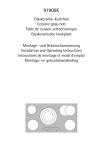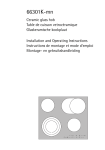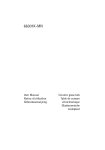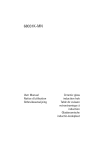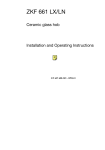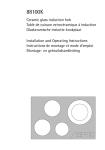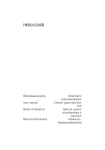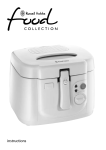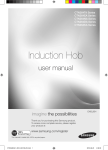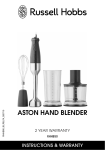Download C81700K-MN User manual - Eurohome Kitchens and Appliances
Transcript
C81700K Glaskeramik-Kochfeld Glaskeramische kookplaat Taque de cuisson vitrocéramique Ceramic glass hob Montage- und Gebrauchsanweisung Montage- en gebruikshandleiding Instructions de montage et mode d’emploi Installation and Operating Instructions Dear Customer, Please read these operating instructions carefully. Above all, please observe the “safety” section on the first few pages. Please retain these operating instructions for future reference. Pass them on to any subsequent owners of the appliance. The warning triangle and/or key words (Warning!, Caution!, Important!) are used to highlight instructions that are important for your safety or for the function of the appliance. It is essential that these instructions are observed. 0 1. This symbol guides you step by step through the operation of the appliance. 2. ... 1 3 This symbol gives you additional information and practical tips on using the appliance. 2 Tips and information about the economical and environmentally friendly use of the machine are marked with the clover leaf. These operating instructions contain information on steps you can take yourself to rectify a possible malfunction. Refer to the section “What to do if...”. Printed on environmentally friendly paper. Thinking ecologically means acting ecologically ... 96 CONTENTS Operating Instructions . . . . . . . . . . . . . . . . . . . . . . . . . . . . . . . . . . . . 98 Safety . . . . . . . . . . . . . . . . . . . . . . . . . . . . . . . . . . . . . . . . . . . . . . . . . . . . . . . . 98 Disposal . . . . . . . . . . . . . . . . . . . . . . . . . . . . . . . . . . . . . . . . . . . . . . . . . . . . . . 101 The Key Features of Your Appliance . . . . . . . . . . . . . . . . . . . . . . . . . . . . . 102 Discription of the hob . . . . . . . . . . . . . . . . . . . . . . . . . . . . . . . . . . . . . . . . . . Hob Surface and Control Panel Features ......................... Digital Displays . . . . . . . . . . . . . . . . . . . . . . . . . . . . . . . . . . . . . . . . . . . . . . . . . Cooking Zone Safety Cut-out . . . . . . . . . . . . . . . . . . . . . . . . . . . . . . . . . . . . 103 103 104 104 Before Using for the First Time . . . . . . . . . . . . . . . . . . . . . . . . . . . . . . . . . 104 Initial Cleaning . . . . . . . . . . . . . . . . . . . . . . . . . . . . . . . . . . . . . . . . . . . . . . . . . 104 Operating the Hob . . . . . . . . . . . . . . . . . . . . . . . . . . . . . . . . . . . . . . . . . . . . . TOUCH CONTROL Sensor Field . . . . . . . . . . . . . . . . . . . . . . . . . . . . . . . . . Switching On the Appliance . . . . . . . . . . . . . . . . . . . . . . . . . . . . . . . . . . . Switching Off the Appliance . . . . . . . . . . . . . . . . . . . . . . . . . . . . . . . . . . . Cooking Zone Selection . . . . . . . . . . . . . . . . . . . . . . . . . . . . . . . . . . . . . . . Heat Setting Selection + and - . . . . . . . . . . . . . . . . . . . . . . . . . . . . . . . . . Switching the Double and Triple Ring Cooking Zone On and Off . . . . Switching the Casserole Zone On and Off . . . . . . . . . . . . . . . . . . . . . . . . Switching off a Cooking Zone . . . . . . . . . . . . . . . . . . . . . . . . . . . . . . . . . Residual Heat Indicator . . . . . . . . . . . . . . . . . . . . . . . . . . . . . . . . . . . . . . . Cooking with the Automatic Warm up Function . . . . . . . . . . . . . . . . . . Cooking without the Automatic Warm up Function . . . . . . . . . . . . . . . Locking/Unlocking the Control Panel . . . . . . . . . . . . . . . . . . . . . . . . . . . Timer . . . . . . . . . . . . . . . . . . . . . . . . . . . . . . . . . . . . . . . . . . . . . . . . . . . . . . 105 105 105 105 106 107 108 110 111 112 113 114 115 116 Uses, Tables and Tips . . . . . . . . . . . . . . . . . . . . . . . . . . . . . . . . . . . . . . . . . . . 118 Pans . . . . . . . . . . . . . . . . . . . . . . . . . . . . . . . . . . . . . . . . . . . . . . . . . . . . . . . . . . 118 Advice on Cooking with and without Automatic Warm up . . . . . . . . . . . . 119 Cleaning and Care . . . . . . . . . . . . . . . . . . . . . . . . . . . . . . . . . . . . . . . . . . . . . 121 Hob . . . . . . . . . . . . . . . . . . . . . . . . . . . . . . . . . . . . . . . . . . . . . . . . . . . . . . . . . . 121 Hob Frame . . . . . . . . . . . . . . . . . . . . . . . . . . . . . . . . . . . . . . . . . . . . . . . . . . . . 122 What do I do if ... . . . . . . . . . . . . . . . . . . . . . . . . . . . . . . . . . . . . . . . . . . . . . 123 Service . . . . . . . . . . . . . . . . . . . . . . . . . . . . . . . . . . . . . . . . . . . . . . . . . . . . . . 125 Assembly . . . . . . . . . . . . . . . . . . . . . . . . . . . . . . . . . . . . . . . . . . . . . . . . . . . . . 126 97 Operating Instructions OPERATING INSTRUCTIONS 1 Safety The safety aspects of this appliance comply with accepted technical standards and the German Appliance Safety Law. However, as manufacturers we also believe it is our responsibility to familiarise you with the following safety instructions. Electrical Safety • The installation and connection of the new appliance must only be carried out by a registered specialist. • Repairs to the appliance are only to be carried out by approved service engineers. Repairs carried out by inexperienced persons may cause injury or serious malfunctioning. If your appliance needs repairing, please contact your local AEG Service Force Centre or your dealer. 3 Please follow these instructions, otherwise the warranty is void in the event of damages. • Flush-mounted appliances may only be operated following installation in suitable installation cabinets and workplaces which conform to the relevant standards. This ensures sufficient protection against contact for electrical units as required by the VDE [Association of German Electrical Engineers]. • If your appliance malfunctions or if fractures, cracks or splits appear: – switch off all cooking zones, – switch off or remove the hob fuse. Child Safety The cooking zones will become hot when you cook. Therefore, always keep small children away from the appliance. 98 Operating Instructions Safety Whilst Using • This appliance may only be used for boiling and frying food in the home. • Do not use the hob to heat the room. • Take care when connecting electric appliances to sockets nearby. Connection cables must not make contact with hot cooking rings. • Overheated fats and oils catch fire quickly. You should supervise cooking when preparing foods in fat or oil (e.g. chips). • Switch off the cooking zones after use. Safety When Cleaning Switch the appliance off before cleaning. For safety reasons cleaning the appliance with a steam jet cleaner or high-pressure water cleaner is not permissible. 99 Operating Instructions To Avoid Damaging your Appliance • Do not use the hob as a work surface or for storage. • Do not operate the cooking zones when there is no pan or the pans are empty. • Glass ceramic is resistant to changes in temperature and very robust; however it is not unbreakable. Especially sharp and hard objects that fall on the cooking surface can damage it. • Do not use cast iron pans or pans with a rough, burred or damaged base. Scratching may occur if the pans are slid across the surface. • Do not place any pans on the hob frame. Scratching and damage to the paint may occur. • Make sure that no acidic liquids, e.g. vinegar, lemon or descaling agents, are spilt onto the hob frame, since these cause dull spots. • If sugar or a preparation with sugar comes into contact with the hot cooking zone and melts there it must be cleaned off immediately with a scraper while it is still hot. If it cools, the surface may be damaged when it is removed. • Keep all items and materials that can melt away from the glass ceramic surface, e.g. plastics, aluminium foil, or oven foils. If something of this nature should melt onto the glass ceramic surface, it must also be removed immediately using the scraper. 100 Operating Instructions 2 Disposal Disposing of the packaging material • All parts of the packaging can be fully recycled; foil and expanded polyurethane parts are appropriately identified. Please dispose of packaging material and, if appropriate, your old appliance properly. • Please follow the national and regional regulations and material identification (material separation, refuse collection, waste disposal sites). Information on disposal • The appliance must not be disposed of with household rubbish. • You can obtain information about collection dates or public refuse disposal sites from your local refuse department or council. • Warning! Before disposing of old appliances make them inoperable. Remove the mains lead. 101 Operating Instructions The Key Features of Your Appliance • Glass ceramic cooking surface: The appliance has a glass ceramic cooking surface and 4 rapid response cooking zones. The particularly powerful radiant heater elements significantly shorten the amount of time taken for the zones to heat up. • Sensor fields: Your appliance is operated using TOUCH CONTROL sensor fields. • Cleaning: The advantage of the glass ceramic cooking surface and the sensor fields is their accessibility for cleaning. The smooth, flat surface is easy to clean (see section: “Cleaning and Care”). • On/Off sensor field: The “On/Off” sensor field provides the appliance with a separate mains switch. Touching this switches the power supply on or off completely. • Displays: Digital displays show information about selected heat settings, functions activated and any possible residual heat in the appropriate cooking zone. • Safety cutoff: A safety cutoff ensures that all cooking zones switch off automatically after a period of time if the setting has not been changed. • Keep warm setting: ! is the setting for keeping foods warm. • Residual heat indicator: An h for residual heat is shown in the display if the cooking zone becomes so hot that there is a risk of burning. • Multipurpose cooking zone: The hob is equipped with a multipurpose/casserole cooking zone. Depending on the setting, it can be used as a round or oval cooking zone, e.g. for oval casseroles or for keeping dishes or food warm. • Double and triple cooking zone: In addition the hob has a double and a triple cooking zone. This means the appliance offers cooking zones of variable sizes, suitable, for example, for smaller milk pans. This enables you to save energy. • Timer: All rings can be automatically switched off using the integrated timer. When the end of the cooking time has been reached, the cooking zone switches off. 102 Operating Instructions Discription of the hob Hob Surface and Control Panel Features mm /145 10 75/2 2 mm 265 mm 145 170 mm m 80 m /1 100 103 Operating Instructions Digital Displays The four display fields that are assigned to the four cooking zones display: – j, after being switched on and when the safety function causes an automatic cut-out, – = when a cooking zone is selected, – ! to ), depending on the selected heat setting, – a during automatic warm up, – h when there is residual heat, – f when there is a fault. 1 Cooking Zone Safety Cut-out If one of the cooking zones is not switched off after a certain time or if the heat setting is not changed, the corresponding cooking zone switches itself off automatically. h appears in the ring display for all rings that are switched on, and j after they have cooled down. The rings are switched off at: • Heat setting 1-2 after 6 hours • Heat setting 3-4 after 5 hours • Heat setting 5 after 4 hours • Heat setting 6-9 after 1.5 hours To switch on, reactivate the cooking zone (see section “Operation”). Before Using for the First Time Initial Cleaning Wipe the glass ceramic surface with a damp cloth. 1 104 Important: Do not use any caustic, abrasive cleaners! The surface could be damaged. Operating Instructions Operating the Hob 3 When a cooking zone is switched on, it may hum briefly. This is a characteristic of all glass ceramic cooking zones and does not impair either the function or the life of the appliance. TOUCH CONTROL Sensor Field To operate the TOUCH CONTROL sensor field place your finger from above flat onto the required field until the appropriate displays come on or go out or else the required function is carried out. Switching On the Appliance 0 3 The entire appliance is switched on using the “On/Off” n sensor field. Touch the “On/Off” sensor field for approx. 2 seconds. The digital displays will show j and the decimal point will flash. Once the “On/Off” sensor field has been operated to switch on the appliance, one of the cooking zones must be selected within approx. 10 seconds using the cooking zone selection buttons. Otherwise the appliance switches off again for safety reasons. Switching Off the Appliance To switch off the appliance completely activate the “On/Off” n sensor field. 105 Operating Instructions 0 Touch the “On/Off” sensor field for approx. 1 second. 3 When an individual cooking zone or the entire hob is switched off, any residual heat is shown with an h (for “Hot”) in the digital display for the appropriate cooking zones. Cooking Zone Selection 0 3 106 To select the required cooking zone touch the corresponding sensor field for approx. one second. A zero with a decimal point will light up in the appropriate cooking zone display window =. The decimal point indicates that settings may only be made for this cooking zone. Operating Instructions 0 3 Heat Setting Selection + and For setting and adjusting the heat setting (! to )) for the selected cooking zone. Use sensor field + to increase the heat setting. Lower the heat setting with sensor field -. If several cooking zones are being used simultaneously, the required cooking zone must be selected by touching the appropriate sensor field before adjusting the heat setting. The decimal point in the display shows which cooking zone has been selected. 107 Operating Instructions Switching the Double and Triple Ring Cooking Zone On and Off Depending on the size of the pot or pan it is possible when using the double or triple ring cooking zone to activiate the larger heating ring in addition to the smaller one using the “booster” (X) sensor field on the glass ceramic hob. 3 These can only be activiated if the smaller ring is already switched on. 1. Select the appropriate cooking zone. 2. Set the required heat setting. 0 3. Touch the “booster” (X) sensor field. 108 Operating Instructions The middle ring is switched on. The control indicator under the symbol II is illuminated. 4. Pressing the “booster” sensor field again activates the outer heating ring. The control indicator under symbol III is illuminated. 5. To switch off the outer heating ring touch the “booster” sensor field; the corresponding heating ring is switched off. 109 Operating Instructions Switching the Casserole Zone On and Off 0 1. Select the appropriate cooking zone. 2. Set the required heat setting. 3. To switch the casserole zone on or off place your finger flat on the “booster” (X) touch control sensor field, until the control indicator comes on or goes off. 110 Operating Instructions Switching off a Cooking Zone 0 1. Select the required cooking zone with the cooking zone sensor fields. 2. Touch sensor fields + and - simultaneously to switch off or turn sensor field - back to zero. 3 A cooking zone may only be switched off when the decimal point is on in the cooking zone display. 111 Operating Instructions Residual Heat Indicator When an individual cooking zone or the entire hob is switched off, any residual heat is shown with an h (for “Hot”) in the digital display for the appropriate cooking zones. Even after the cooking zone has been switched off, the residual heat indicator only goes out when the cooking zone is cold. 2 1 You can use the residual heat for melting and keeping food warm. 1 Important! If the power supply is interrupted the h symbol will also go out and information about residual heat will no longer be available. However, it is still possible to burn yourself. This can be avoided by being particularly attentive. 112 Important! As long as the residual heat indicator is illuminated, there is a risk of burns. Operating Instructions Cooking with the Automatic Warm up Function All four of the hob's cooking zones can be controlled in nine stages and have an automatic warm up function: – !, lowest heat setting – ), highest heat setting – a, automatic warm up function When you select the required heat setting using the + sensor field, the cooking zone will work for a specific time on full power and then switch automatically to the set heat setting. The duration of the automatic warm up function depends on the heat setting selected. 0 1. Select the required cooking zone with the cooking zone sensor fields. Touch sensor field + until it reaches the required heat ! to (. The set heat setting will be displayed first. After five seconds a (= automatic warm up function) will replace the heat setting in the display. At the end of the warm up time the heat setting will be shown again. 3 If during the automatic warm up function you select a higher setting, eg. from # to %, the warm up time is adjusted to match. If you select a lower setting, the warm up time ends at once. 113 Operating Instructions 2 If you start cooking again on a cooking zone that is still warm, the automatic warm up function uses the residual heat. This saves time and energy. 3 If you again wish to switch on a cooking zone on which hot items are already standing, you should always select the required heat setting with the - sensor field. In this way you can avoid making the food boil over as a result of the extra burst of heat from the automatic warm up. Cooking without the Automatic Warm up Function If you wish to use the cooking zone without automatic warm up, select the required heat setting with the - sensor field. 0 1. Switch on the appliance and select the desired cooking zone using the cooking zone selection buttons. 2. Touch sensor field - to select the required heat setting from ) to !. 3 You can adjust the heat setting at any time using the + and - buttons, providing the cooking zone has been selected. Switching off a cooking zone 0 1. Select the desired cooking zone using the cooking zone buttons. 2. Press the + and - buttons simultaneously to switch off. 1 114 When the rings are still hot cooking should be carried out without automatic warm up. Operating Instructions Locking/Unlocking the Control Panel With the exception of the “On/Off” sensor field the control panel can be locked at any required time during cooking in order to prevent adjusting the settings such as when wiping over with a cloth. This function is also suitable as a child safety feature. 0 1. Touch the o sensor field until the control indicator comes on. 2. To release the lock touch the o sensor field again continuously until the control indicator goes out. 3 Child safety feature! If the hob is completely switched off using the “On/Off” sensor field while the lock is on, then the lock will still be active when the hob is switched on again. To reactivate the cooking zones, the locking function must be cancelled as described above. 115 Operating Instructions Timer A cooking duration can be set with the integrated timer for all cooking zones. When the end of the cooking duration is reached, the cooking zone switches itself off automatically. 0 1. Using the cooking zone sensor field, select the required cooking zone and set the required heat setting. 2. Touch the TIMER W sensor field to activate the timer function for this cooking zone. 00 will appear in the display. 3. Using the + or - sensor fields set or adjust the required period of time until the zone is to switch off automatically (eg. 15 minutes). After a few seconds the timer will start automatically and will show how much time remains before it will switch off. In addition, the “Timer aktive” display for the relevant cooking zone will light up, e.g. the top left control indicator corresponds to the rear left cooking zone. At the end of the set cooking time, the cooking zone will switch off automatically and an acoustic signal will sound. 4. Touch the TIMER W sensor field to switch off the signal and control indicator. 116 Operating Instructions 3 To set the timer more quickly, leave your finger on the + or - sensor field until the required time is reached. If the - sensor field is operated first, the time setting will begin at 99 minutes; if the + sensor field is operated first, the time setting will begin at 1 minute. Displaying the remaining cooking time 0 If you select a cooking zone which is in timer mode, the cooking time still remaining appears in the timer display window. Using the timer to measure short periods of time (“egg timer”) 3 The timer function can also be used to measure short times without the automatic switch-off function, provided the timer is not already being used for 1 or more cooking zones. No cooking zone may be selected in this case. The cooking zone sensor field with the decimal point in the display must therefore be touched again so that the decimal point goes out. Set the time as described above. Ending the timer function prematurely There are two ways of switching off the timer early: Switching off the cooking zone and timer simultaneously 0 1. Select the desired cooking zone using the cooking zone buttons. 2. Touch the + and - buttons simultaneously: The cooking zone and timer will switch off. Switching off the timer - leaving the cooking zone active 0 1. Select the desired cooking zone using the cooking zone buttons. 2. Touch the “Timer” button again 3. Touch the + and - buttons simultaneously: – Only the timer will switch off. – The cooking zone will stay on. 117 Operating Instructions Uses, Tables and Tips Pans The better the pan, the better the results. • You can recognise good pans by their bases. The base should be as thick and flat as possible. • Pay particular attention when buying new pans to the diameter of the base. Manufacturers often give only the diameter of the upper rim. • Pots with aluminium or copper bases can cause metallic discolouring on the glass ceramic surface, which is very difficult or impossible to remove. • Do not use cast iron pans or pans with a rough, burred or damaged base. This can produce permanent scratching if the pan is slid across the surface. • When cold, pan bases are normally bowed slightly inwards (concave). They should never be bowed outwards (convex). • If you wish to use special types of pan (e.g. a pressure cooker, simmering pan, wok, etc.), please observe the manufacturer's instructions. 2 118 Energy saving tips You can save valuable energy by observing the following points: • Always position pots and pans before switching on the cooking zone. • Dirty cooking zones and pan bases increase power consumption. • Whenever possible always position the lids firmly on pots and pans to cover completely. • Switch off the cooking zones before the end of the cooking time to use the residual heat such as to keep foods warm or for melting. • The base of the pan should be the same size as the cooking zone. • Using a pressure cooker reduces cooking times by up to 50%. Operating Instructions Advice on Cooking with and without Automatic Warm up The automatic warm up function is suitable for: • dishes that start off cold, are heated up at high power and do not need to be continually watched when cooking on the selected heat setting, • dishes that are put in a hot frying pan. The automatic warm up function is not suitable for: • goulash, beef olives and similar braised dishes that need continual turning until browned correctly, have liquid added and are then braised until cooked, • dumplings, pasta dishes with large amounts of liquid, • cooking with pressure cookers, • very large quantities of soup/stew with more than 2 litres of liquid. General notes: 3 • When cooking without the automatic warm up function, we recommend the use of a high heat setting to warm up the food (using the - button) and then leaving the dish to finish cooking at an appropriate lower heat setting. • You can use the ! heat setting for keeping food warm. • Take special note of the results when you first use the appliance! You can then decide which heat setting is the best for "your dishes" in the "quantities you are accustomed to preparing" with "your pans". You will then quickly appreciate the advantages of the automatic function and will feel secure about using your new hob. 119 Operating Instructions Indicative Figures for Cooking with the Rings The information given in the following tables is for guidance. The switch setting required for cooking depends on the quality of the pans and on the type and quantity of food Switch Setting Automatic Warm Up Time1 (Min.) Warming up Frying Deep-fat frying 9 8 4.5 7 3.5 6 2.5 5 8.5 4 6.5 3 4.8 2 3.0 1 Cooking Process 1.0 Examples of Usage Warming up large amounts of liquid, boiling pasta, browning meat, (browning goulash, pot-roast) Steaks, pieces of loin, potato fritters, Hot-fat frying fried sausages, pancakes, doughnuts Frying Schnitzel/cutlets, liver, fish, rissoles, fried eggs Boiling Boiling up to 1.5 l liquid, potatoes, vegetables Steaming Sautéing Poaching Steaming and sautéing small quantities of vegetables, cooking rice and milk-based dishes Keeping foods warm, Keeping warm melting butter, dissolving gelatine, melting melting chocolate 1) When cooking without the automatic warm up function, the warm up time can be selected as required. 3 120 When heating up or frying, we recommend using the warm up setting “9” and then continue cooking foods that require longer cooking times at an appropriate lower heat setting. Operating Instructions Cleaning and Care Hob 1 Important: Cleaning agents must not come into contact with the hot glass ceramic surface! All cleaning agents must be removed with plenty of clean water after cleaning because they can have a caustic effect when the rings are next heated! Do not use any aggressive cleaners such as grill or oven sprays, coarse scourers or abrasive pan cleaners. 3 Clean the glass ceramic surface after each use when it is warm to the touch or cold. This will avoid spillages becoming burnt on. Remove scale and water marks, fat spots and discolouration with a metallic shimmer using a commercially available glass ceramic or stainless steel cleaner such as “Hob Brite”. Light Soiling 0 1. Wipe the glass ceramic surface with a damp cloth and a little washing up liquid. 2. Then rub dry with a clean cloth. Remnants of cleaner must not be left on the surface. 3. Thoroughly clean the entire glass ceramic cooking surface once a week with a commercially available glass ceramic or stainless steel cleaner. 4. Then wipe the glass ceramic surface using plenty of clean water and rub dry with a clean fluff-free cloth. Stubborn Soiling 0 1. To remove food that has boiled over or stubborn splashes, use a glass scraper. 2. Place the glass scraper at an angle to the glass ceramic surface. 3. Remove soiling by sliding the blade. 3 You can obtain glass scrapers and glass ceramic cleaners from specialist retailers. 121 Operating Instructions 1 Problem Dirt 0 1. Remove burnt-on sugar, melted plas- tic, aluminium foil or other meltable materials with a glass scraper immediately and while still hot. Important: There is a risk of burning yourself when the glass scraper is used on a hot cooking zone! 2. Then clean the hob normally when it has cooled down. 1 3 If the cooking zone on which something has melted has already cooled down, warm it up again for cleaning. Scratches or dark marks on the glass ceramic surface, caused for example by a pan base with sharp edges, cannot be removed. However, they do not impair the function of the hob. Hob Frame Important! Do not put vinegar, lemon-juice or scale removers on the hob frame, otherwise dull spots will appear. 0 1. Wipe the frame with a damp cloth and a little washing up liquid. 2. Soften dried dirt with a wet cloth. Then wipe off and rub dry. 1 122 Operating Instructions What do I do if ... Rectifying Malfunctions It is possible that any malfunction has been caused by a minor error, which you can correct yourself with the help of the following instructions. Do not attempt any further repairs if the following instructions do not help in each specific case. 1 Warning! Repairs to the appliance are only to be carried out by approved service engineers. Improperly effected repairs may result in considerable risk to the user. If your appliance needs repairing, please contact your specialist dealer or customer service. What do I do if ... 0 0 0 .... the cooking zones do not work? Check whether – the mains fuse (fuse box) is intact or the circuit breaker (at the household fuse box) has tripped. If the circuit breaker trips or the fuse blows several times, please call an approved electrician. – the appliance has been properly switched on, – the control indicators in the control panel are on, – the correct cooking zone has been switched on, – the cooking zones are set to the desired heat setting for cooking (see section “Cooking”), – the cooking zones have been switched off by the safety switch (siehe section “Safety functions”). .... the cooking zones cannot be switched on? Check whether – the control panel is locked (see section “Locking the control panel”). – more than 10 seconds have elapsed between operating the On/Off button and switching on the desired cooking zone, (see section “Switching on the appliance”). – the sensor fields are partially covered by a damp cloth or with liquid. .... the display suddenly changes to j or h for residual heat? Check whether – the On/Off button has been operated accidentally. – the sensor fields are partially covered by a damp cloth, liquid or similar. – the safety switch has been activated. 123 Operating Instructions 0 0 0 .... after switching off the cooking zones, neither j nor h for residual heat appears in the display? Check whether – the cooking zone was only used for a short period and is therefore not hot enough. If the cooking zone is hot, call AEG customer service. .... a cooking zone cannot be switched off? Check whether – the touch switches are partially covered by a damp cloth or liquid. – the lock is activated. .... a cooking zone cannot be switched on? Check whether – the lock is activated. .... f is shown in the display? Check whether the cooking zone has been overheated. This indicator lights up to show overheating, electronic faults or for safety reasons. If you call in customer service to resolve a problem caused by incorrect operation of the appliance, the customer service engineer's visit will not be free of charge, even during the warranty period. 124 Service SERVICE In the “What to do if …” section a number of malfunctions are listed that you can rectify yourself Look there first if a fault occurs. Is it a technical fault? If so, please contact your customer service centre. (You will find addresses and telephone numbers in the section “Customer Service Centres”.) Always prepare in advance for the discussion. This will make diagnosis of the problem easier and also make it easier to decide if a customer service visit is necessary: Please make a note of the following information as accurately as possible: • What form does the fault take? • Under what circumstances does the fault occur? Prior to the telephone call it is important that you make a note of the following appliance code numbers that are given on the rating plate: • PNC code (9 digits), • S No code (9 digits). We recommend that you record the code numbers here so that you always have them to hand: PNC . . . . . . . . . S No . . . . . . . . . When do you incur costs even during the warranty period? • if you could have remedied the fault yourself using the fault table (see section “What do I do if ...”), • if the customer service technician has to make several journeys because he was not provided with all the relevant information before his visit and therefore, forexample, has to fetch spare parts. These multiple trips can be avoided if you prepare your phone call as described above. 125 Montage/Assembly 126 min. 25 mm min. 5 mm Ausbau / Demontage / Démontage / Removal 127

































